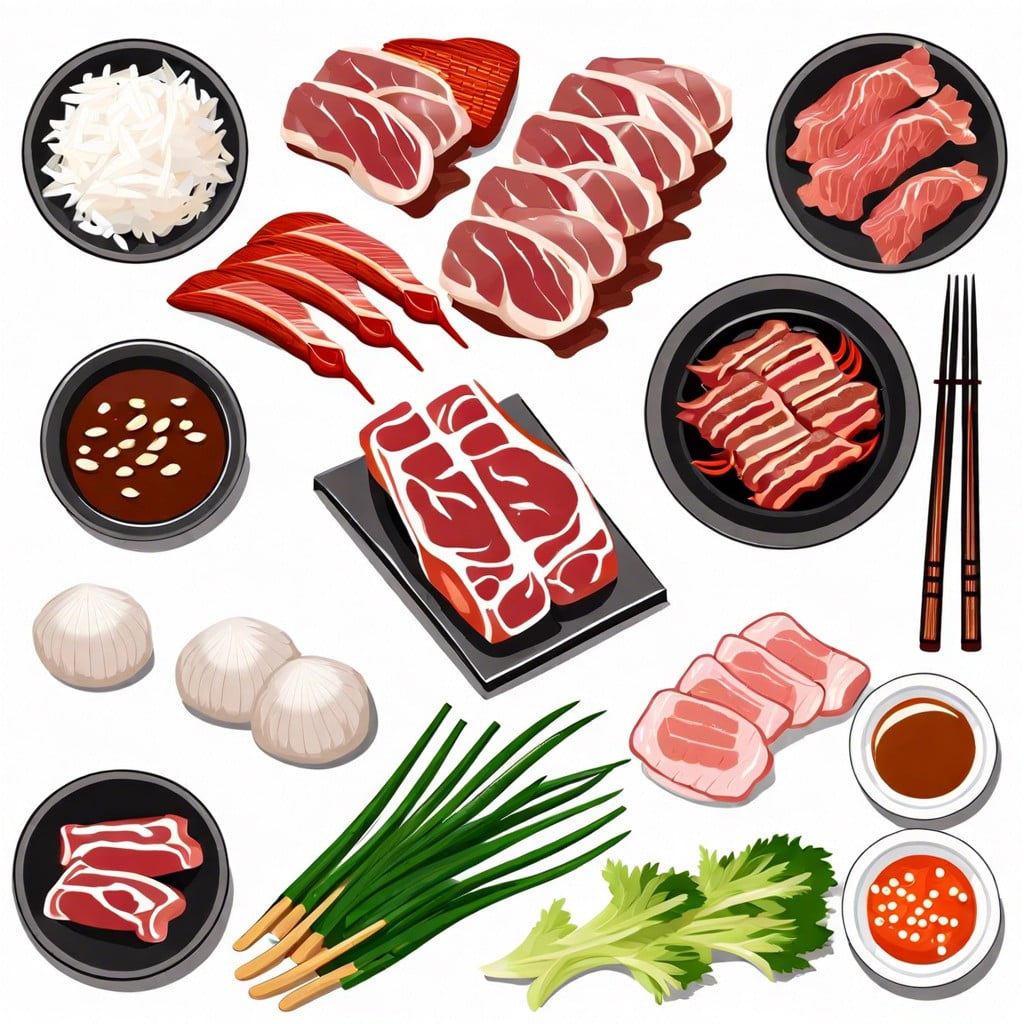In this article, you will learn the essentials of Korean BBQ, including its distinctive features and how to enjoy it authentically.
Key takeaways:
- Choose the right meats for Korean BBQ: bulgogi, galbi, and samgyeopsal.
- Use a marinade with soy sauce, sugar, sesame oil, garlic, and gochujang or pear puree.
- Thinly slice the meats to maximize surface area for quick cooking and flavor absorption.
- Set up your grill properly and manage heat to prevent burning.
- Use the right tools and monitor doneness to avoid overcooking.
Essential Ingredients for Korean BBQ

Selecting the right meats is crucial—bulgogi and galbi, thinly sliced beef and marinated short ribs, respectively, are classic choices. Pork belly, known as samgyeopsal, is also popular for its succulent flavor when grilled.
Marination plays a pivotal role in achieving the authentic taste of Korean BBQ. A mixture typically involves soy sauce, sugar, sesame oil, garlic, and gochujang or pear puree to tenderize and imbue the meat with a balance of sweet, savory, and umami notes.
Garnishes such as thinly sliced green onions, toasted sesame seeds, and a touch of sesame oil can elevate the final dish, adding layers of texture and enhanced flavor.
Types of Meats for Korean BBQ
Traditionally, beef takes center stage, with bulgogi (thinly sliced ribeye) and galbi (short ribs) being incredibly popular choices. These cuts are prized for their tenderness and marbling which enhance flavor upon grilling. Pork is another favorite, with pork belly, known as samgyeopsal, offering a rich, savory option for those who favor its indulgent texture.
Poultry, while less common, is not absent from the table. Dak (chicken) prepared in a gochujang-based sauce provides a spicy kick for diners. For a leaner alternative, jumulleok, or seasoned beef sirloin, offers a succulent taste without the higher fat content found in pork or marbled beef cuts.
Regardless of the choice, these meats share a defining characteristic – they are commonly sliced thin to maximize surface area, allowing them to cook quickly and absorb the flavors of the marinade or seasoning, resulting in a harmonious blend of taste and texture.
Key Marinade Components
Selecting the right marinade is pivotal in enhancing the flavors characteristic of Korean BBQ. Soy sauce provides a savory base, infusing the meat with umami. Sweet elements, such as sugar or Asian pear puree, balance the umami with a subtle, fruity sweetness that caramelizes beautifully on the grill.
Garlic and onions are essential aromatics, contributing depth and a sharp zest. Sesame oil rounds out the marinade, adding a nutty essence and aiding in creating that desirable char. Finally, incorporating gochujang or red pepper flakes introduces a gentle heat that completes the complex flavor profile.
Always remember to adjust quantities to suit the type of meat and personal taste preferences.
Korean BBQ Techniques
Grill setup is crucial: Traditional Korean BBQ utilizes a gas or charcoal grill, often built into the dining table. When grilling at home, a portable stovetop grill pan can replicate this experience.
Heat management is key: The grill should provide enough heat to cook thin meat slices quickly while still being adjustable to prevent burning.
Charcoal grilling tips: For those using charcoal, maintain a consistent supply to ensure even cooking temperatures. Lump charcoal preferred for its cleaner burn.
Use the right tools: Tongs and scissors are the go-to for turning and cutting meat on the grill, respectively — a technique that ensures even cooking and easy serving.
Watch for doneness: Unlike thicker cuts, the thinly sliced meat common in Korean BBQ cooks rapidly. Monitoring closely avoids overcooking, which compromises flavor and texture.
Grill Setup and Heat Management
For optimal results, your grill should accommodate both direct and indirect heat zones. Charcoal grills are traditionally favored for their high heat and smoke that imparts a distinct flavor. However, gas grills offer convenience and easier temperature control.
When setting up a charcoal grill, arrange coals on one side for a hot zone, ideal for searing meat quickly. The other side should remain coal-free, offering a cooler zone where meat can continue to cook without burning. This method allows for dynamic cooking—adjust the proximity of the meat to the heat source based on its thickness and your desired doneness.
On gas grills, achieve this by setting different burners to high and low temperatures. Preheating the grill is crucial—a good 10 to 15 minutes on high heat ensures a sear-worthy surface temperature. Once seared, move items to the cooler part of the grill to cook through.
Monitoring and managing grill temperature is integral to Korean BBQ. Use a grill thermometer to gauge heat levels accurately. Aim for a temperature around 250-300°F on the cooler side for slow-cooked items like thick cuts or whole poultry, and 400-450°F for the hot zone, perfect for quickly cooking thin slices of marinated meat.
Additionally, if you’re using a grill with a lid, closing it will trap heat and cook food more evenly, mimicking an oven-like environment which can be ideal for certain Korean BBQ dishes that benefit from steady cooking temperatures.

